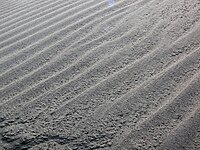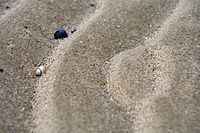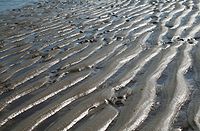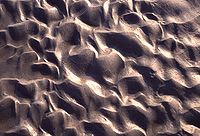Haworth is a hub of attraction for those who like the Bronte sisters, and on many days the place has a international feel, with many languages including Yorkshire being spoken  . Time moves on over the centuries, and you may wonder if the Bronte sisters would recognise the area as it is now, but do you want to see what they may have seen? I don't mean the parsonage, or Top Withens, what I mean is the surface they may have walked on. Look at your feet at the location, and you will see flagtones.
. Time moves on over the centuries, and you may wonder if the Bronte sisters would recognise the area as it is now, but do you want to see what they may have seen? I don't mean the parsonage, or Top Withens, what I mean is the surface they may have walked on. Look at your feet at the location, and you will see flagtones.
What is Flagstone?
Flagstone is a type of sedimentary rock, relatively easy to split or quarry in slabs, and hence ideal for paving. It is also used for making fences and roofing.
When was it laid down?
The rocks that lie underneath the valleys and hills of Northern England were formed millions of years ago at a time when the whole of what is now the North of England was covered by huge river deltas and lagoons. Sediments, mainly sands, silts and muds, were eroded from hills in an area that now includes Scandinavia and Greenland and were swept into vast river deltas and lagoons in a central basin in a position now occupied by the Pennines. The sediment settled to the bottom as the water slowed down in the deltas and lagoons. The nearest equivalent sediments of today are forming in huge river deltas such as the Mississippi delta. This sediment built up until it was hundreds of metres thick and was gradually compacted and cemented into the “sedimentary” rocks we know today. To geologists they form part of the Millstone Grit series. The overall thickness of sediments indicate infilling of a tremendous basin, yet features in the rocks, such as ripples like those on a beach, show shallow water conditions, so sediment infill must have kept pace with large-scale subsidence.
Why is this area special?
Now, I want you to look at each of the paving slabs, some of them are smooth, some are not, one has ripple marks, though not like raspberry ripple ice cream, but like you find on a beach. When you have found this paving slab (it is a bit cracked), you are standing near or on an ancient marine bedform. Wow, marks from the Carboniferous area  .
.
Ripple Marks
Ripple marks are sedimentary structures, and indicate agitation by water (current or waves) or wind. This being geology there are different types of ripples.
 Straight ripples generate cross-laminae that all dip in the same direction, and lay in the same plane. These forms of ripples are constructed by unidirectional flow of the current.
Straight ripples generate cross-laminae that all dip in the same direction, and lay in the same plane. These forms of ripples are constructed by unidirectional flow of the current.
 Sinuous ripples generate cross-laminae that are curvy. They show a pattern of curving up and down as shown in picture. Sinuous ripples produce trough cross lamination. All laminae formed under this type of ripple dip at an angle to the flow as well as downstream. These are also formed by unidirectional flow of current.
Sinuous ripples generate cross-laminae that are curvy. They show a pattern of curving up and down as shown in picture. Sinuous ripples produce trough cross lamination. All laminae formed under this type of ripple dip at an angle to the flow as well as downstream. These are also formed by unidirectional flow of current.
 Catenary ripples generate cross-laminae that are curvy but have a unidirectional swoop. They show a pattern similar to what a repeated "W" would look like. Like the sinuous ripples, this form of ripple is created by unidirectional flow with the dip at an angle to the flow as well as downstream.
Catenary ripples generate cross-laminae that are curvy but have a unidirectional swoop. They show a pattern similar to what a repeated "W" would look like. Like the sinuous ripples, this form of ripple is created by unidirectional flow with the dip at an angle to the flow as well as downstream.
 Linguoid ripples have lee slope surfaces that are curved generating a laminae similar to caternary and sinuous ripples. Linguoid ripples generate an angle to the flow as well as downstream. Linguoid ripples have a random shape rather than a "W" shape, as described in the catenary description.
Linguoid ripples have lee slope surfaces that are curved generating a laminae similar to caternary and sinuous ripples. Linguoid ripples generate an angle to the flow as well as downstream. Linguoid ripples have a random shape rather than a "W" shape, as described in the catenary description.
This being an earthcache, in order to log it, I ask that you answer some questions. Please send them to me, and do not include them in your log. You can send them to me by using the message facility or email, both of which can be found by looking at my profile.
1. Generally what colour is the flagstone?
2. Find the ripple marked flagstone, please describe the ripples, i.e are they wavy, long, straight and size etc....
3. What type of ripples are you looking at?